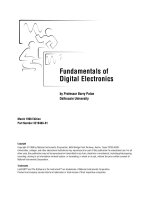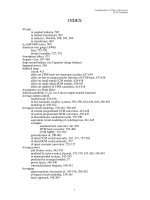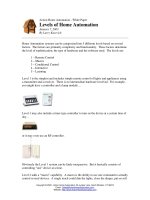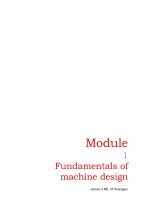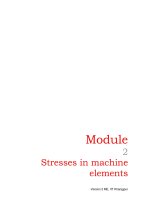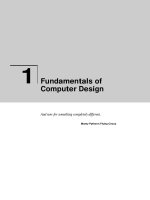Tài liệu Fundamentals of Digital Electronics doc
Bạn đang xem bản rút gọn của tài liệu. Xem và tải ngay bản đầy đủ của tài liệu tại đây (536.71 KB, 82 trang )
Fundamentals of
Digital Electronics
March 1998 Edition
Part Number 321948A-01
Fundamentals of Digital Electronics
Copyright
Copyright © 1998 by National Instruments Corporation, 6504 Bridge Point Parkway, Austin, Texas 78730-5039.
Universities, colleges, and other educational institutions may reproduce all or part of this publication for educational use. For all
other uses, this publication may not be reproduced or transmitted in any form, electronic or mechanical, including photocopying,
recording, storing in an information retrieval system, or translating, in whole or in part, without the prior written consent of
National Instruments Corporation.
Trademarks
LabVIEW™ and The Software is the Instrument™ are trademarks of National Instruments Corporation.
Product and company names listed are trademarks or trade names of their respective companies.
by Professor Barry Paton
Dalhousie University
For More Information
If you have any questions or comments regarding this course manual, please see the following
web site: Electronics/.
Australia 03 9879 5166, Austria 0662 45 79 90 0, Belgium 02 757 00 20, Brazil 011 288 3336, Canada (Ontario) 905 785 0085,
Canada (Québec) 514 694 8521, Denmark 45 76 26 00, Finland 09 725 725 11, France 01 48 14 24 24, Germany 089 741 31 30,
Hong Kong 2645 3186, Israel 03 6120092, Italy 02 413091, Japan 03 5472 2970, Korea 02 596 7456, Mexico 5 520 2635,
Netherlands 0348 433466, Norway 32 84 84 00, Singapore 2265886, Spain 91 640 0085, Sweden 08 730 49 70,
Switzerland 056 200 51 51, Taiwan 02 377 1200, United Kingdom 01635 523545
National Instruments Corporate Headquarters
6504 Bridge Point Parkway Austin, Texas 78730-5039 Tel: 512 794 0100
International Offices
Contents
© National Instruments Corporation iii Fundamentals of Digital Electronics
Introduction
Lab 1
Gates
The AND Gate...............................................................................................1-1
The OR and XOR Gates ................................................................................1-2
Negation.........................................................................................................1-2
The NAND, NOR, and NXOR Gates............................................................1-2
Building Gates from Other Gates ..................................................................1-3
Gates with More than Two Inputs .................................................................1-4
Masking .........................................................................................................1-5
Application: Data Selector.............................................................................1-6
Name that Gate ..............................................................................................1-6
Lab 1 Library VIs ..........................................................................................1-6
Lab 2
Encoders and Decoders
The Die ..........................................................................................................2-2
Modulo 6 Counter..........................................................................................2-3
Encode ...........................................................................................................2-4
Virtual Dice ...................................................................................................2-5
Lab 2 Library VIs ..........................................................................................2-6
Lab 3
Binary Addition
Adder Expansion (Half Adder, Full Adders).................................................3-3
Binary Coded Decimal (BCD).......................................................................3-5
LabVIEW Challenge .....................................................................................3-6
Lab 3 Library VIs ..........................................................................................3-6
Contents
Fundamentals of Digital Electronics iv © National Instruments Corporation
Lab 4
Memory: The D-Latch
Shift Registers................................................................................................4-2
LabVIEW Challenge: The Bucket Brigade ...................................................4-4
Ring Counters ................................................................................................4-4
Lab 4 Library VIs ..........................................................................................4-5
Lab 5
Pseudo-Random Number Generators
A 6-Bit Pseudo-Random Number Generator.................................................5-1
An 8-Bit Pseudo-Random Sequencer ............................................................5-2
8-Bit Pseudo-Random Number Generator.....................................................5-5
Encryption of Digital Data.............................................................................5-6
Lab 5 Library VIs ..........................................................................................5-7
Lab 6
JK Master-Slave Flip-Flop
Binary Counters (1-Bit, 2-Bit, and 4-Bit)......................................................6-3
8-Bit Binary Counter (with and without Reset).............................................6-5
Summary........................................................................................................6-5
Lab 6 Library VIs ..........................................................................................6-6
Lab 7
Digital-to-Analog Converter
What is a DAC?.............................................................................................7-1
ALU Simulator ..............................................................................................7-3
Simulating a Real DAC Chip.........................................................................7-4
Waveform Generators....................................................................................7-5
Special DACs.................................................................................................7-6
Lissajous Figures ...........................................................................................7-7
Lab 7 Library VIs ..........................................................................................7-8
Lab 8
Analog-to-Digital Converters, Part I
Purpose of the Analog-to-Digital Converter..................................................8-1
The Ramp ADC .............................................................................................8-2
Tracking ADC................................................................................................8-4
Lab 8 Library VIs ..........................................................................................8-6
Lab 9
Analog-to-Digital Converters, Part II
SAR Simulation.............................................................................................9-3
Summary........................................................................................................9-4
Lab 9 Library VIs ..........................................................................................9-4
Contents
© National Instruments Corporation v Fundamentals of Digital Electronics
Lab 10
Seven-Segment Digital Displays
Seven-Segment Display.................................................................................10-1
Lab 10 Library VIs ........................................................................................10-5
Lab 11
Serial Communications
Serial Transmitter ..........................................................................................11-2
Voltage to Serial Transmitter.........................................................................11-4
Lab 11 Library VIs ........................................................................................11-5
Lab 12
Central Processing Unit
Operation of the Arithmetic and Logic Unit..................................................12-2
The Accumulator ...........................................................................................12-3
Addition .........................................................................................................12-4
Binary Counter...............................................................................................12-5
Lab 12 Library VIs ........................................................................................12-6
©
National Instruments Corporation I-1 Fundamentals of Digital Electronics
Introduction
Digital electronics is one of the fundamental courses found in all electrical
engineering and most science programs. The great variety of LabVIEW
Boolean and numeric controls/indicators, together with the wealth of
programming structures and functions, make LabVIEW an excellent tool to
visualize and demonstrate many of the fundamental concepts of digital
electronics. The inherent modularity of LabVIEW is exploited in the same
way that complex digital integrated circuits are built from circuits of less
complexity, which in turn are built from fundamental gates. This manual
is designed as a teaching resource to be used in the classroom as
demonstrations, in tutorial sessions as collaborative studies, or in the
laboratory as interactive exercises.
The order of the labs follows most electronic textbooks. The first six labs
cover the fundamental circuits of gates, encoders, binary addition,
D-latches, ring counters, and JK flip-flops. Many of the VIs are suitable for
both classroom demonstration and laboratory exploration.
The second set of six labs cover advanced topics such as DACs, ADCs,
seven-segment displays, serial communication, and the CPU. These are best
done in the context of a digital electronics lab, comparing the LabVIEW
simulations with real integrated circuits. In each case, you can enhance
simulations presented in the text by using a National Instruments DAQ
board to interact with the real world through LabVIEW digital I/O, analog
out, analog in, and serial VIs.
Labs 2, 5, and 12 are application oriented and are designed to demonstrate
encoding schemes, digital encryption, and the operation of a CPU. These
labs could be presented as challenging problems in a tutorial setting or in a
workshop environment.
The labs can also be grouped to demonstrate special relationships of
advanced devices on certain basic gates. For example, the CPU operation is
dependent on the concept of registers and two input operations.
This manual includes a complete set of LabVIEW VIs. The text is also
included on the CD so that you can customize the material.
©
National Instruments Corporation 1-1 Fundamentals of Digital Electronics
Lab 1
Gates
Gates are the fundamental building blocks of digital logic circuitry. These
devices function by “opening” or “closing” to admit or reject the passage of
a logical signal. From only a handful of basic gate types (AND, OR, XOR,
and NOT), a vast array of gating functions can be created.
The AND Gate
A basic AND gate consists of two inputs and an output. If the two inputs
are A and B, the output (often called Q) is “on” only if both A and B are
also “on.”
In digital electronics, the on state is often represented by a 1 and the off state
by a 0. The relationship between the input signals and the output signals is
often summarized in a truth table, which is a tabulation of all possible inputs
and the resulting outputs. For the AND gate, there are four possible
combinations of input states: A=0, B=0; A=0, B=1; A=1, B=0; and A=1, B=1.
In the following truth table, these are listed in the left and middle columns.
The AND gate output is listed in the right column.
Table 1-1.
Truth Table for AND Gate
A B Q=A AND B
0
0
1
1
0
1
0
1
0
0
0
1
Fundamentals of Digital Electronics 1-2
©
National Instruments Corporation
Lab 1 Gates
In LabVIEW, you can specify a digital logic input by toggling a Boolean
switch; a Boolean LED indicator can indicate an output. Because the AND
gate is provided as a basic built-in LabVIEW function, you can easily wire
two switches to the gate inputs and an indicator LED to the output to
produce a simple VI that demonstrates the AND gate.
Figure 1-1.
LabVIEW AND Function Wired to I/O Terminal Boxes
Run AND gate.vi from the Chap 1.llb VI library. Push the two input buttons
and note how the output indicator changes. Verify the above truth table.
The OR and XOR Gates
The OR gate is also a two-input, single-output gate. Unlike the AND gate,
the output is 1 when one input, or the other, or both are 1. The OR gate
output is 0 only when both inputs are 0.
Figure 1-2.
Digital Symbols for the OR and XOR Gates
A related gate is the XOR, or eXclusive OR gate, in which the output is 1
when one, and only one, of the inputs is 1. In other words, the XOR output
is 1 if the inputs are different.
Negation
Figure 1-3.
The NOT Gate
An even simpler gate is the NOT gate. It has only one input and one output.
The output is always the opposite (or negation) of the input.
The NAND, NOR, and NXOR Gates
Negation is quite useful. In addition to the three two-input gates already
discussed (AND, OR, and XOR), three more are commonly available. These
are identical to AND, OR, and XOR, except that the gate output has been
A
B
Q
OR
A
B
QXOR
A A
Lab 1 Gates
©
National Instruments Corporation 1-3 Fundamentals of Digital Electronics
negated. These gates are called the NAND (“not AND”), NOR (“not OR”),
and NXOR (“not exclusive OR”) gates. Their symbols are just the symbols
of the unnegated gate with a small circle drawn at the output:
Figure 1-4.
Negated AND, OR, and XOR Gates
Run Truth table.vi. Choose a gate and try all combinations of A and B to
complete the following truth tables.
Building Gates from Other Gates
Given a handful of NAND gates, you can reproduce all other basic logic
gates. For example, you can form the NOT gate by connecting both NAND
input terminals to the same input:
Figure 1-5.
NOT Gate Built from a NAND Gate
Similarly, you can easily build an AND gate from two NAND gates:
Figure 1-6.
AND Gate from Two NAND Gates
Table 1-2.
Truth Tables for the Digital Logic Basic Gates
A B AND OR XOR NAND NOR NXOR
0 0 0
0 1 0
1 0 0
1 1 1
A
B
Q
A
B
Q
A
B
Q
Fundamentals of Digital Electronics 1-4
©
National Instruments Corporation
Lab 1 Gates
An OR requires three NAND gates:
Figure 1-7.
OR Gate from Three NAND Gates
Construct a VI that demonstrates that an XOR gate can be constructed from
four NAND gates. For reference, see XOR from NAND.vi in the Lab 1 VI
library.
Gates with More than Two Inputs
Although LabVIEW includes all the basic two-input gates, you may require
more inputs. For example, the AND truth table above can be generalized to
three inputs:
From a pair of two-input AND gates, you can easily build a VI that
implements the three-input AND:
Figure 1-8.
LabVIEW Program for a Three-Input AND Gate
Open the VI called 3 AND.vi and notice the socket and icon, making this VI
a full-fledged subVI.
Table 1-3.
Truth Table for a Three-Point Input AND Gate
A B C A AND B AND C
0 0 0 0
0 0 1 0
0 1 0 0
0 1 1 0
1 0 0 0
1 0 1 0
1 1 0 0
1 1 1 1
Lab 1 Gates
©
National Instruments Corporation 1-5 Fundamentals of Digital Electronics
Masking
As a simple application of how these basic logic gates can be combined,
consider the concept of masking. To illustrate this concept, below is the
AND truth table with relabeled column headings.
The truth table makes the point that the AND gate can be used as an
electronic switch.
This point is easily demonstrated in LabVIEW:
Figure 1-9.
AND Gate Used as an Electronic Switch
Load and run E-switch.vi to observe the electronic switch in action. You can
view the truth tables of other gates from a masking point of view as well. In
the following table, reset means “forced to 0” while set means “forced to 1”:
In summary, there are three useful functions here. To set a state, use OR with
a mask of 1. To reset a state, use AND with a mask of 0. To invert a state,
use XOR with a mask of 1.
Table 1-4.
Truth Table for AND Gate with One Input as a Mask
A Mask A AND B Effect
0
1
0
0
0
0
A is blocked Gate is “closed”
0
1
1
1
0
1
A is unchanged Gate is “open”
Table 1-5.
Truth Table for AND, OR and XOR Gates with One Input as a Mask
A Mask AND OR XOR
0
1
0
0
A is reset A is unchanged A is unchanged
0
1
1
1
A is unchanged A is set A is inverted
Fundamentals of Digital Electronics 1-6
©
National Instruments Corporation
Lab 1 Gates
Application: Data Selector
Another simple application of basic gates is the data selector, in which a
single digital input selects one of two digital streams:
Figure 1-10.
A Digital Data Selector Built with Basic Gates
LabVIEW includes a built-in function, called Select, to emulate this
operation. Thus, you could rewire the above as:
Figure 1-11.
LabVIEW’s Version of a Digital Data Selector
Name that Gate
The gates in this section form the foundation of much of digital electronics.
A complete familiarity with the truth tables is extremely useful. As a review,
test your skills with the Name that gate VI.
Lab 1 Library VIs (Listed in the Order Presented)
• AND gate.vi (two-input AND operation)
• Truth table.vi (for AND, OR, XOR, NAND, NOR, and NXOR)
• XOR from NAND.vi
• 3 AND.vi (three-input AND operation)
• Masking.vi (demonstration)
• E-switch.vi (electronic switch)
• Data select.vi (data selector using basic logic gates)
• Data select2.vi (data selector using the LabVIEW Select function)
• Oscillator.vi (subVI used in Data select.vi)
• Name that gate.vi (test your knowledge)
©
National Instruments Corporation 2-1 Fundamentals of Digital Electronics
Lab 2
Encoders and Decoders
An encoder converts an input device state into a binary representation of
ones or zeros. Consider a rotary switch with 10 positions used to input the
numbers 0 through 9. Each switch position is to be encoded by a unique
binary sequence. For example, switch position 7 might be encoded as 0111.
A decoder performs the opposite conversion, from binary codes into output
codes.
Consider the case of a single die. On each of its six sides, one of the
following patterns appears, representing the numbers 1-6.
Figure 2-1.
The Six Sides of a Die
These patterns are traditional. They can be thought of as seven lights
arranged in an “H” pattern:
Figure 2-2.
Dot Arrangement Used in Dice Codes
By turning on the appropriate lights, you can create any of the six patterns
on the face of a die.
Fundamentals of Digital Electronics 2-2
©
National Instruments Corporation
Lab 2 Encoders and Decoders
On closer inspection, there are only four unique patterns from which the
pattern for any face can be formed. Call these base patterns A, B, C, and D:
Figure 2-3.
Four Base Patterns Used in Dice Codes
If you write down the truth table, for the presence or absence of these base
patterns as a function of die face, the meaning of these base states becomes
clear.
The base pattern A is used by all odd numbers (1, 3, and 5). Pattern B is in
the representation of all of the numbers except 1. Base pattern C is found in
the numbers 4, 5, and 6. Pattern D is used only when representing 6.
The Die
To build a virtual die, place seven LED indicators in the “H” pattern on the
front panel, together with four switches. On the diagram page, the LED
terminals are wired to display the four unique patterns A, B, C, and D. The
four switches on the front panel can now simulate turning on and off the base
patterns.
Figure 2-4.
LabVIEW Front Panel for Virtual Die Display
Table 2-1.
Base States Used for Each Die Number
Die Face A B C D
1
√
2
√
3
√ √
4
√ √
5
√ √ √
6
√ √ √
ABCD
Lab 2 Encoders and Decoders
©
National Instruments Corporation 2-3 Fundamentals of Digital Electronics
Figure 2-5.
LabVIEW Block Diagram to Implement Virtual Die Display
Load the VI Display.vi and observe the operation of the virtual die.
Modulo 6 Counter
A modulo 6 counter is any counter with six unique states that repeat in
sequence. You can build a simple modulo 6 counter using a three-element
shift register with the last element output inverted and feedback into the first
element input. (Such a counter is often called a switched tail ring counter.)
Open a new LabVIEW VI. Place three LED indicators on the front panel.
These will show the output state of the shift register elements called Q1, Q2,
and Q3. On the block diagram, use a shift register with three elements, each
wired to one LED indicator. You can use a Wait function to slow down the
action for demonstration. Note that the While Loop control is left unwired.
Each time this VI is called, the next value is returned. On the front panel,
select the three outputs as connections in the icon editor and save this
program as a subVI called Rotate.vi.
Figure 2-6.
Rotate.vi Front Panel and Block Diagram
Fundamentals of Digital Electronics 2-4
©
National Instruments Corporation
Lab 2 Encoders and Decoders
Below is the truth table for the modulo 6 counter. Run the program seven
times to observe the action.
The output repeats after six counts, hence the name modulo 6 counter.
Encoder
There is no a priori reason to decide which output corresponds to which
count. However, a little foresight makes the choices easier:
For example, each output has three (1) states and three (0) states. One of
these outputs, for example Q3, could signify odd states 1, 3, and 5. Another
output state, for example Q2′, can then signify the family 4, 5, 6. These two
lines then decode two of the base patterns for “free.” The two remaining
base patterns are decoded with a particular pattern of the three counter
lines. To this end, a three-input AND gate built in the last lab together with
an inverter can be used. Not 1 (Base Pattern B) is decoded with the
combination Q1 & Q2 & Q3, and the final base state “6” is decoded with
Q1′ & Q2′ & Q3′.
Table 2-2.
Truth Table for Modulo 6 Counter
Cycle Q1 Q2 Q3
1
2
3
4
5
6
7
0
1
1
1
0
0
0
0
0
1
1
1
0
0
0
0
0
1
1
1
0
same as cycle 1
Table 2-3.
Digital Die Encoding Scheme
# Q1 Q2 Q3 Q1
′
Q2
′
Q3
′
6 0 0 0 1 1 1
4 1 0 0 0 1 1
2 1 1 0 0 0 1
1 1 1 1 0 0 0
3 0 1 1 1 0 0
5 0 0 1 1 1 0
Lab 2 Encoders and Decoders
©
National Instruments Corporation 2-5 Fundamentals of Digital Electronics
Figure 2-7.
Encode.vi Front Panel and Block Diagram
The encoder is built by placing three Boolean indicators on the front panel
together with four LED indicators. The encoder is wired by translating the
words of the above paragraph into a circuit.
Virtual Dice
Figure 2-8.
Function Schematic for Digital Dice
To roll the virtual die, a high-speed counter will cycle through the six states.
These states are encoded on three output lines. In practice, the counter
cycles until a stop command is issued to the counter. Whatever state the
counter has on its output will be the roll value. A clock with a speed greater
than 1 kHz ensures the randomness of the roll.
An encoder VI converts the three counter lines into the four control lines for
the base patterns. These in turn set the dots on the virtual die to the correct
output code.
It is now a simple case of assembling all the components—counter, encoder
and display—into a VI called Dice.vi. Just as you would build electronic
circuits by assembling gates, latches, switches, and displays, LabVIEW
simulates this process by building complex functions from simpler ones.
(modulo 6)
stop
EncoderCounter
Fundamentals of Digital Electronics 2-6
©
National Instruments Corporation
Lab 2 Encoders and Decoders
Figure 2-9.
Dice.vi Block Diagram. Note the Similarity with the Function Schematic Above
Now, flip the front panel switch and let the good times roll!
Lab 2 Library VIs (Listed in the Order Presented)
• Display.vi (LED displays for virtual die)
• Rotate.vi (modulo 6 counter)
• Encoder.vi (converts counter codes to display codes)
• 3 AND.vi (subVI used in Encoder.vi)
• Dice.vi (let the good times roll)
©
National Instruments Corporation 3-1 Fundamentals of Digital Electronics
Lab 3
Binary Addition
Before proceeding with this lab, it is helpful to review some details of binary
addition. Just as in decimal addition, adding 0 to any value leaves
that number unchanged: 0 + 0 = 0, while 1 + 0 = 1. However, when you add
1 + 1 in binary addition, the result is not “2” (a symbol which does not exist
in the binary number system), but “10”; a “1” in the “twos place” and a zero
in the “ones place.” If you write this addition vertically, you would recite,
“One and one are two; write down the zero, carry the one”:
1
+1
10
Figure 3-1.
Single-Bit Addition
Below is the truth table for single-bit addition. There are two input columns,
one for each addend, A1 and A2, and two output columns, one for the
ones-place sum and one for the carried bit:
Table 3-1.
Truth Table for Addition
A1 + A2 = Sum with Carry
00
01
10
11
00
10
10
01
Fundamentals of Digital Electronics 3-2
©
National Instruments Corporation
Lab 3 Binary Addition
Which of the fundamental gates can you use to implement the output
columns? Note that A1 XOR A2 reproduces the Sum output, and A1 AND
A2 the Carry output, so a LabVIEW implementation of this 1-bit addition
truth table is
Figure 3-2.
Half Adder Built from XOR and AND Gates
This digital building block is called a “half adder.” The term “half adder”
refers to the fact that while this configuration can generate a signal to
indicate a carry to the next highest order bit, it cannot accept a carry from a
lower-order adder.
A “full adder” has three inputs. In addition to the two addends, there is also
a “carry in” input, which adds the bit carried from the previous column, as
in the middle column in the following example:
101
+101
1010
Figure 3-3.
Three-Bit Binary Addition
The truth table for a single-bit full adder therefore has three inputs, and thus
eight possible states:
Table 3-2.
Truth Table for Addition with a Carry In
Carry In A1 A2 Sum Carry Out
0 0 0 0 0
0 0 1 1 0
0 1 0 1 0
0 1 1 0 1
1 0 0 1 0
1 0 1 0 1
1 1 0 0 1
1 1 1 1 1
Lab 3 Binary Addition
©
National Instruments Corporation 3-3 Fundamentals of Digital Electronics
Note that all three inputs are essentially equivalent; the full adder simply
adds the three inputs. One way to build a 1-bit full adder is by combining
two half adders:
Figure 3-4.
Full Adder Using Two Half Adder SubVIs
Note the simplicity achieved in the wiring diagram by using the half adders.
Adder Expansion
You can construct a device that adds multibit binary numbers by combining
1-bit adders. Each single-bit adder performs the addition in one “column” of
a sum such as
1011
+0010
1101
Figure 3-5.
4-Bit Binary Addition (11+2=13)
For example, a 4-bit adder could be constructed in LabVIEW as:
Figure 3-6.
LabVIEW Block Diagram for 4-Bit Binary Addition
Note that this VI uses four 1-bit full adders. If you plan to add only 4-bit
numbers with this circuit, the lowest-order adder could be a half adder. The
Fundamentals of Digital Electronics 3-4
©
National Instruments Corporation
Lab 3 Binary Addition
use of all full adders allows the 4-bit adder to have a carry-in input, as well
as the two 4-bit addend inputs. Load Four-bit Adder1.vi and observe the
addition of two 4-bit numbers. It uses two subVIs, Full Adder.vi, shown in
Figure 3-4, and Half Adder.vi, shown in Figure 3-2.
As you can see, the wiring above is somewhat complicated and would
become even more complex if you extended the adder to more bits. By using
a LabVIEW For Loop with a shift register, you can simplify the wiring
significantly:
Figure 3-7.
4-Bit Binary Addition Using LabVIEW Arrays (Four-Bit Adder2.vi)
Note how the four independent bits are formed into 4-bit arrays before
passing into the interior of the For Loop, which iterates four times, each time
adding a pair of bits, starting at the least significant bit. On the first iteration,
the carry input to the 1-bit full adder is from the panel carry input; on
subsequent iterations, it is the carry from the previous iteration. Run both
versions of the VI and confirm that their behaviors are identical.
Figure 3-8.
4-Bit Adder Using Array Inputs and Outputs
Lab 3 Binary Addition
©
National Instruments Corporation 3-5 Fundamentals of Digital Electronics
There is also a third version of the above VI, named simply Four-bit
Adder3.vi, which is identical to Figure 3-7 above except that the inputs and
outputs are displayed as Boolean arrays. Note that in Boolean arrays, the
LSB is on the left and the MSB is on the right. This version has been
configured as a subVI, and you can combine two of these to create an 8-bit
adder. Note that each 8-bit (one-byte) addend is separated into two 4-bit
“nibbles,” and then the two “least significant nibbles” are sent to one 4-bit
adder, while the two “most significant nibbles” go to a second 4-bit adder.
Figure 3-9.
8-Bit Adder Using Two 4-Bit Adders
Binary Coded Decimal (BCD)
Not all digital arithmetic is performed by a direct conversion to the base-2
representation. Binary coded decimal, or BCD, representation is also used.
In BCD, each decimal digit is separately encoded in four bits as follows:
BCD can be considered to be a subset of full binary notation, in which only
the states 0000 to 1001 (0 to 9) are used. For example,
Table 3-3.
BCD Representation for the Numbers 0 to 9
Decimal Digit BCD Representation Decimal Digit BCD Representation
0 0000 5 0101
1 0001 6 0110
2 0010 7 0111
3 0011 8 1000
4 0100 9 1001
42
10
0100 0010
BCD
=
Fundamentals of Digital Electronics 3-6
©
National Instruments Corporation
Lab 3 Binary Addition
Note that this is distinct from the binary representation, which in this case
would be
Clearly, BCD is wasteful of bits, because there are a number of 4-bit patterns
that are not used to encode a decimal digit. The waste becomes more
pronounced for larger integers. Two bytes (16 bits) is enough to encode
unsigned decimal integers in the range 0-65535 if the binary representation
is used, but the same two bytes will span only the range 0-9999 when using
BCD. The advantage of BCD is that it maps cleanly to decimal output
displays.
LabVIEW Challenge
Create a BCD encoder that takes as its input a digit in the range 0-9 and
outputs the 4-bit BCD representation. Build a BCD decoder that reverses the
behavior of the above encoder. Build a one-digit BCD adder.
Lab 3 Library VIs (Listed in the Order Presented)
• Half Adder.vi (single-bit addition)
• Full Adder.vi (single-bit addition with carry in)
• Four-bit Adder1.vi (adds two 4-bit numbers with carry in)
• Four-bit Adder2.vi (simplified version)
• Four-bit Adder3.vi (uses Boolean arrays for inputs and outputs)
• Eight-bit Adder.vi (uses two 4-bit adders)
42
10
00101010
2
=
©
National Instruments Corporation 4-1 Fundamentals of Digital Electronics
Lab 4
Memory: The D-Latch
In the first three labs in this series, all your work has been with
combinational circuits in which the input states completely determine the
output states. In the circuits thus far, there is no dependence on past history
or how you arrived at the current state. This means that “remembering”
cannot be built into the circuits. Most digital operations are sequential, in
that event B must occur after event A. Furthermore, in a digital computer,
events are not only sequential but also synchronous with some external
clock. Clocked logic devices are devices whose output changes only when
a clock signal is asserted. In the next few labs, you will see how the addition
of clocked logic devices brings memory into digital circuits, making it
possible to construct many interesting digital circuits.
One simple memory circuit is called the data latch, or D-latch. This is a
device which, when “told” to do so via the clock input, notes the state of its
input and holds that state at its output. The output state remains unchanged
even if the input state changes, until another update request is received.
Traditionally, the input of the D-latch is designated by D and the latched
output by Q. The update command is provided by asserting the clock input
in the form of a transition (from HI to LO) or (from LO to HI), so-called
edge-triggered devices or level triggered devices, where the output follows
the input whenever the clock is HI.
